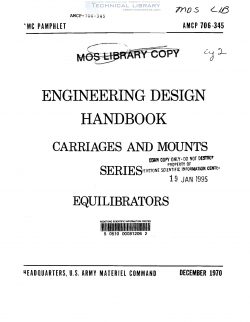AMCP-706-345
- Version
- 195 Downloads
- 3.19 MB File Size
- 1 File Count
- March 5, 2017 Create Date
- March 5, 2017 Last Updated
▼ Scroll for Details ▼
Engineering Design Handbook - Carriages and Mounts Series - Equilibrators

1. This handbook, one of a series on Car- riages and Mounts, describes equilibrators, their characteristics, functions, requirements and design features. 2. Mobile artillery should have a low sil- houette and low center of gravity and yet be able to fire at high, as well as low, eleva- tion. To provide clearance for recoil at high elevation, it is necessary that the recoiling parts be placed well forward with respect to the trunnions. This places the center of grav- ity of the tipping parts ahead of the trun- nions, and creates a muzzle preponderance, or weight moment. This weight moment, without further provision is balanced by a couple applied at the trunnions and elevating gear, but the large force on the gear requires more effort for elevating. Hence, it is desira- ble to eliminate, or at least reduce, the weight moment by balancing either with counter- weights or some mechanical device. A mechanical device is to counter- weights because of saving in weight, space, and moment of inertia of tipping parts. 3. The most effective and desirable method of balancing the tipping parts is by the use Of an equilibrator. An equilibrator is a force- producing mechanism whose function is to provide a balancing moment. One such mo- ment to be balanced is the muzzle preponder-
ance of the tipping parts. Figure 1 shows a typical equilibrator installation. 4. The muzzle preponderance of artillery is little affected by changes in ammunition weight. However, this must be considered in dealing with other typcs of weapons, such as missile launchers. Here, the weight of the missile is large compared with that of the tipping parts. After a missile is launched, the weight moment has changed sufficiently to affect equilibrium. Provisions must be made to balance the new weight moment. Equili- brators now being designed will respond to the changing moment.
| File | Action |
|---|---|
| AMCP-706-345 Engineering Design Handbook - Carriages and Mounts Series - Equilibrators.pdf | Download |
Comment On This Post